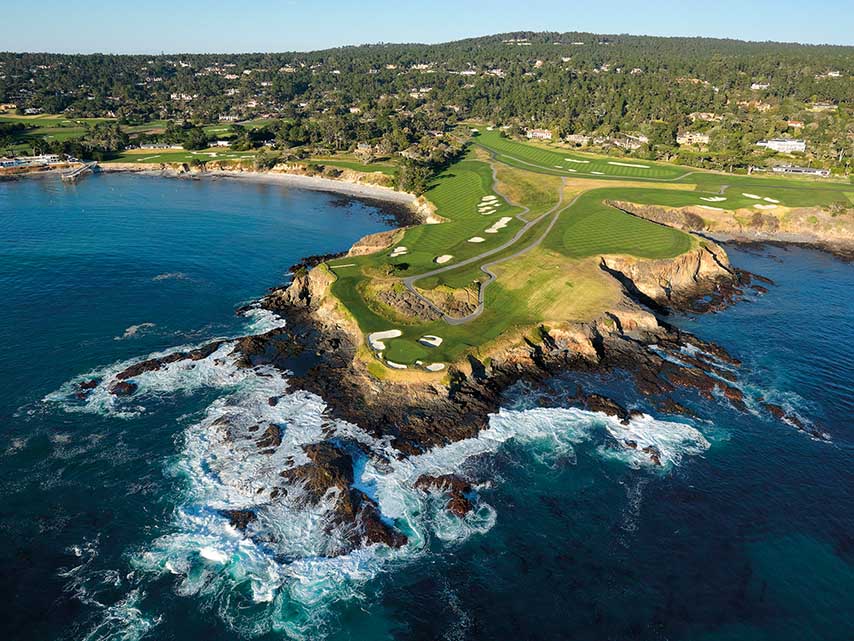"If I only had one more round to play, I would choose to play it at Pebble Beach." This is what Jack Nicklaus, the greatest player in the history of the game (at least numerically, with 18 majors), said of the Californian course. And, as the venue for six US Opens and a PGA Championships, among other US PGA Tour events, it is unquestionably an extraordinary course.
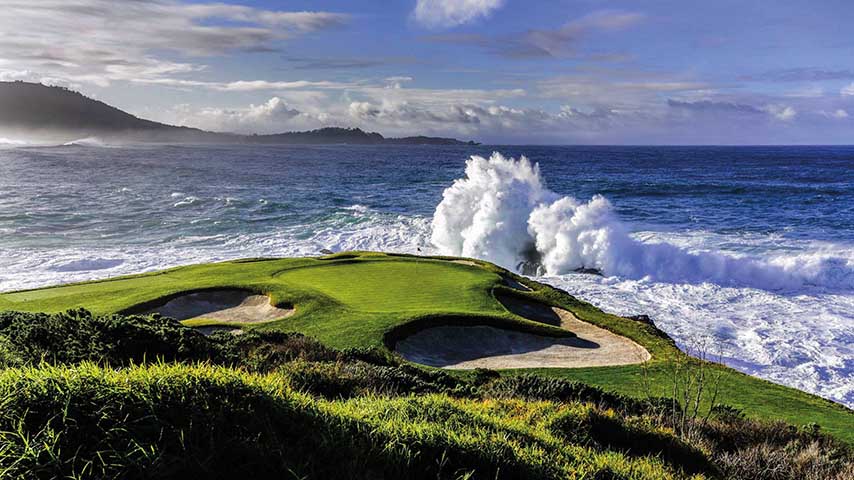
Nestled on the west coast of the United States, on the Californian Monterey Peninsula, and considered one of the most beautiful courses in the world, Pebble Beach Golf Links embraces the rugged coastline and has sweeping views of the Pacific. Half of its holes (from the fourth to 10th, plus the 17th and 18th) are on the edge of the often raging waters that do not always honour the ocean’s name. Holes six, seven and eight comprise Pebble Beach’s “Amen Corner”.
Since, in 2003, Golf Digest created its ranking of the 100 best public course in the United States, Pebble Beach has been number one continuously.
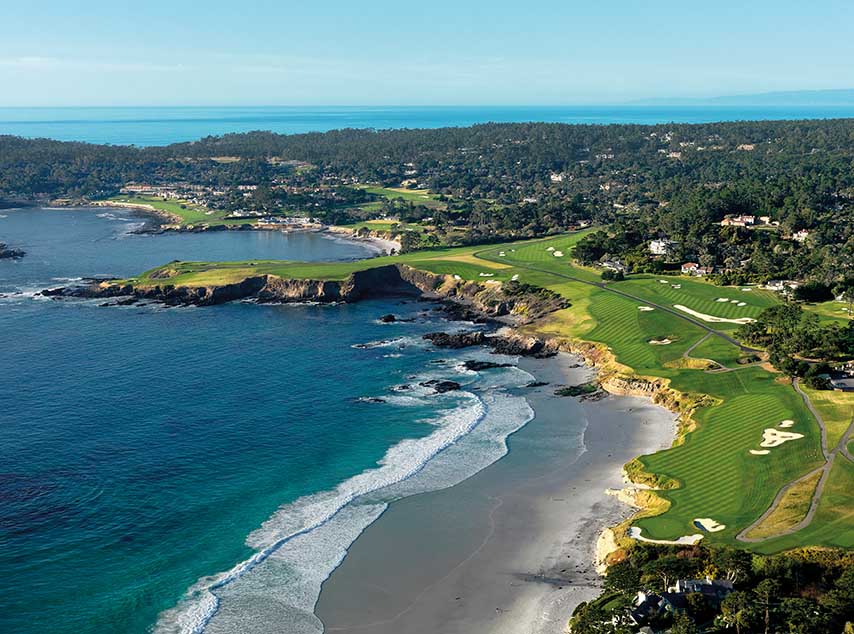
Although it has several spectacular holes, undoubtedly the most famous – and photographed – at Pebble Beach Golf Links is the seventh, and it doesn’t even reach 100 metres (109 yards). This par-three, with an elevated tee and a green surrounded by bunkers, enjoys stunning views of the ocean swirling below the cliff-face. However, don’t be taken in by its short length, especially when the wind blows. Although for many it is a fun hole, for others it is quite the opposite.
None other than Sam Snead himself played from the tee using a putter to avoid the wind, which must have been blowing like never before that day. And a club professional, in the days of the Bing Crosby Clambake Pro-Am, carded a hole-in-one on the seventh with a three-iron! Nor would the 20 players who closed the final round of the 1992 US Open have been having much fun: only two of them managed to get their ball to land on the seventh green, because of the fearsome wind sweeping the hole.
The eighth hole, 390 metres long, is considered by many to be the best par-four in the world. It is best to hit a powerful drive and leave your ball near the cliff so you can see the green. From there you face one of the most spectacular second shots in the world, about 180 metres downhill, over a 30-metre high cliff above the Pacific Ocean.
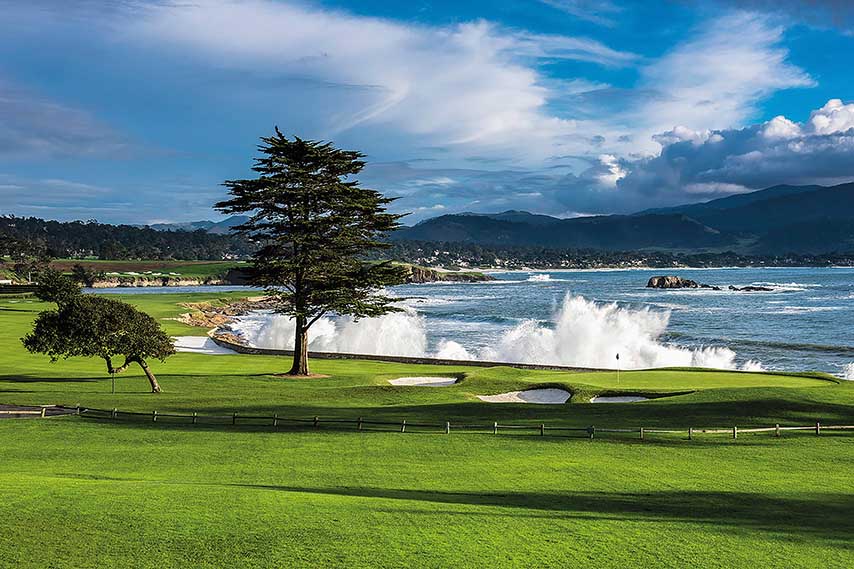
The 17th, a 188-metre par-three, is located on a smaller peninsula to the west of the one that contains holes six, seven and eight. Although the sea beats along the left side of the hole, the main challenge is its length and its unusually contoured green: long and thin, inclined about 45 degrees from the angle of the golfer on the tee. Depending on the flag position and the wind, it is possible to use a wide variety of clubs for the tee shot; and, although the green is wide, the landing area for any approach is relatively small and is also well protected by bunkers.
The 18th is a par-five, 490 metres, where on windy days the waves break strongly on the left side of the hole, providing impressive images. It is one of the most famous final holes in the world. Big-hitters who are feeling bold may try to reach the green in two, but they will need to send their tee shots to the left of a tree on the fairway.
.
CENTENARY
The course’s history dates back a century, as it was in 1919 when the layout designed by Jack Neville and Douglas Grant was created, and opened, as part of the Hotel Del Monte resort.
Ten years after its inauguration, Pebble Beach Golf Links was the scene of its first major, the 1929 US Amateur. At that time, both the US and the British Amateur championships were considered majors. Bobby Jones, who had won the US Open shortly before, achieved the record of three consecutive US Amateur victories that year at Pebble Beach.
The famous Californian course returned to host this tournament in 1947 and 1961, registering victories by Skee Riegel and Jack Nicklaus. This was the first of five wins the Golden Bear would reap at Pebble Beach (also the 1967, 1972 and 1973 Bing Crosby Pro-Ams, and 1972 US Open).
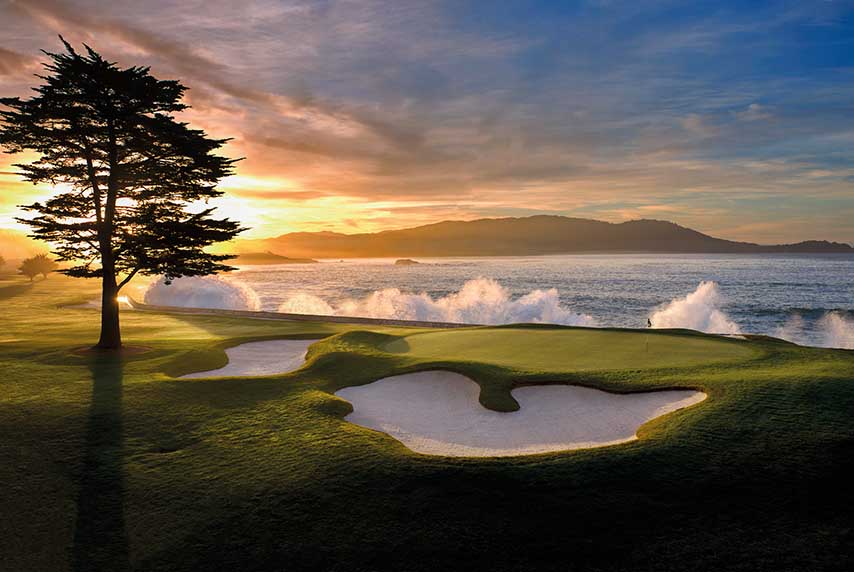
In addition, the famous Monterey Peninsula course was the scene of two women’s majors: the 1940 and 1948 US Women’s Amateur, which at that time was listed as a major. In the first edition Betty Jameson prevailed, having already won the previous year, and in the second the winner was Grace Lenczyk.
Eleven years would pass after the last men’s amateur major tournament before the first professional Grand Slam tournament was held at Pebble Beach: the 1972 US Open. During a final round that recorded the highest average score in the tournament since World War II (78.8), Nicklaus dominated the tournament from day one. It was his 11th victory in a major, or 13th if the two US Amateur wins were included.
In 1977, Pebble Beach hosted the US PGA Championship, with victory settled in a play-off between Gene Littler and Lanny Wadkins, the latter prevailing on the third extra hole.
The US Open would return to the course in 1982, when Tom Watson defeated Nicklaus by two strokes, having been tied at the start of the final day.
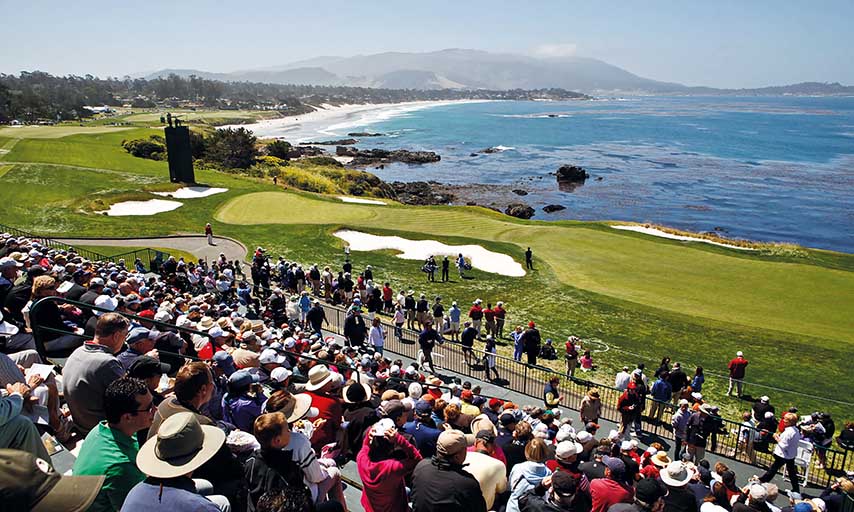
In 1992, Tom Kite won the US Open at Pebble Beach; Tiger Woods would do the same in 2000, Northern Irishman Graeme McDowell raised the trophy aloft in 2010; and in 2019, in the Pebble Beach centenary edition, Gary Woodland was crowned US Open champion.
Among the majors that the course has scheduled for the future are its first US Women’s Open, in 2023; and, in 2027, the seventh men’s US Open.
THE BING CROSBY TOURNAMENT
Every February, since 1947, the US PGA Tour has been holding the AT&T Pebble Beach Pro-Am, a tradition whose predecessor was the Bing Crosby Clambake, created in 1937 by the famous actor who gave it his name and was an avid golfer, handicap-two at the time.
Crosby put his own money into the prize fund ($10,000) and his objective was to bring famous colleagues from Hollywood who played golf to a tournament at Rancho Santa Fe Country Club, close to where he lived in San Diego – playing a pro-am format. The first Crosby Clambake was won by Sam Snead, who pocketed a $500 cheque for his win. Unsurprisingly, the tournament became the most popular on the US West Coast.
After World War II, in 1947, Crosby moved the tournament to northern California, to the Monterey Peninsula, outside San Francisco, where there were several outstanding courses that ideally suited his needs.
By then, the tournament had grown so much that it was necessary to play it at two courses. Players would alternate between Cypress Point and Monterey Peninsula during the first three rounds, while the final would be played at Pebble Beach.
TARZAN'S SHOT
One of the most oft-repeated stories from the Crosby Clambake occurred in the early 1950s at Cypress Point, where Johnny Weissmuller, the former Olympic swimming champion and most famous screen Tarzan, hit a ball that ended up in a tree.
He climbed up the tree and managed to hit the ball out onto the fairway, but before he came down he hung himself with one hand from a branch and with the other hit his chest and launched his famous Tarzan shout, as he had done in so many films.
Other Hollywood celebrities who have played in the tournament include stars such as Jack Lemmon, Dean Martin, Paul Newman, Jack Nicholson, Bob Hope, Samy David Jr and Clint Eastwood.
Crosby, incidentally, died from a heart attack after playing golf in Spain, at the La Moraleja club in Madrid. The actor, who had Manolo Piñero as a playing partner, died when he was heading to the clubhouse after finishing his round.
.
.
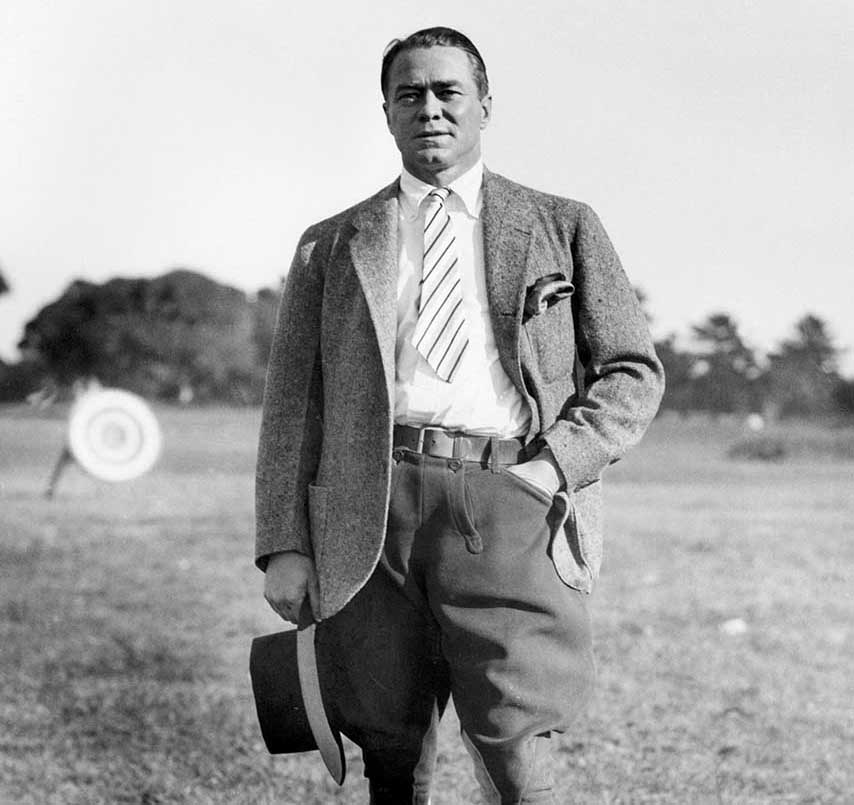
CONSERVATIONIST WHO CREATED PEBBLE BEACH
At the beginning of the last century, businessman Samuel F.B. Morse was the liquidator of a company that wanted to get rid of the assets of a failed real estate investment it had made in the Monterey Peninsula. Morse thought that a golf course attached to the sea would help sales and convinced the company to invest in the construction of Pebble Beach Golf Links. When the course had been built, Morse acquired it together with a vast area of land, in total 7,284 hectares, for which he paid $1.34 million.
Morse was known as El Duque Del Monte (Hotel Del Monte was the first hotel resort built in the United States, and the most luxurious, from its opening in 1890 until 1942). The huge complex included vast green areas, both forest and landscaped, polo fields, a race track and a golf course.
A distant cousin of the inventor of the telegraph and morse code, Samuel F.B. graduated as an engineer from Yale University and in 1905 inherited a massive fortune when his father died. In 1919, he acquired 2,832 hectares on the Monterey Coast, which included Hotel Del Monte and Pebble Beach, and other properties that occupied an additional 4,500 hectares.
Morse planned to develop a residential community within the forest, centred around Del Monte Lodge, and also had plans for the rest of the area. Immediately, Morse, a committed conservationist, banned unnecessary clearing and speculation on these forest lands, and established green belts for wildlife preservation, prioritising the safeguarding of the forest, coast and shoreline.
.
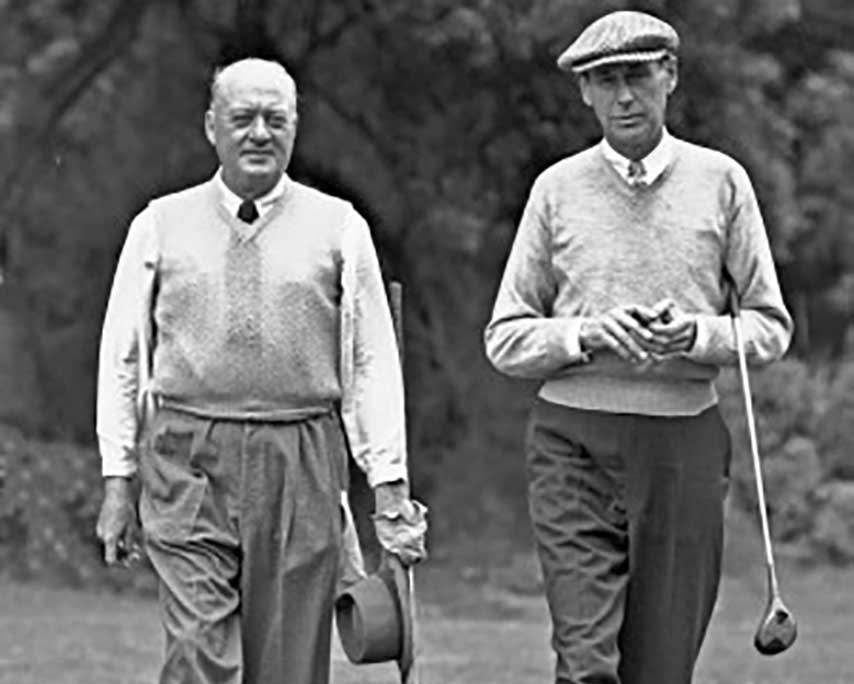
ATYPICAL DESIGNERS
Although neither Jack Neville nor Douglas Grant had experience designing golf courses, the pair created one of the finest championship layouts in the world. Pebble Beach Golf Links has undergone very few changes throughout its century of existence, which is testimony to the extraordinary talent and vision of both golfers.
"Everything was in sight," Neville said of the plot where the golf course would be built. “There was not much to do. The important thing, of course, was to get as many holes as possible along the bay. It took a little imagination, but not much. Years before its construction, I imagined this place as a golf course. Nature intended it to be nothing more. All we did was cut some trees, install sprinklers and sow a few seeds.”
When he was asked to build Pebble Beach, Neville had twice won the California State Amateur Championship – the first at 20 years of age – and later he won three more. He also enjoyed the excitement of playing with Bobby Jones for two rounds at the 1929 US Amateur. Neville stayed in Pebble Beach as a real estate salesman for most of his life, and helped Peter Hay design his nine-hole Pebble Beach course in 1957. There are reports suggesting that he made a preliminary design for another resort area, The Links at Spanish Bay, but there are no drawings. Sandy Tatum also consulted with Neville while preparing Pebble Beach for the 1972 US Open. Neville died in 1978 aged 86.
For his part, Grant had won the 1908 Pacific Coast Championship before moving to England. He returned to California in 1916 due to World War I. On his return, he finished second in the 1916 Western Amateur in Del Monte, and was a medallist for three consecutive years in the California Amateur (1917-1919). In late 1919, Grant returned to England with his family, where he won many other championships and was captain of the Royal St. George’s Golf Club in Sandwich. He died in 1966 aged 78.
.
IN BRIEF
SIZE DOES MATTER
The greens at Pebble Beach are an average of 325 square metres, the smallest on the US PGA Tour. They are surrounded by Stillwater Cove, are affected by an ocean breeze, and are protected by more bunkers (117) than the Old Course at St. Andrews. As Rich Beem once said of them, they seem as small as a dime.
LOVE AT FIRST SIGHT
“When I went out and saw it for the first time, it became my number one golf course in the world. I think that, if you ask the professionals, everyone will say something similar.” – for Fred Funk, winner of eight titles on the US PGA Tour, it was undoubtedly love at first sight.
FIRST SUDDEN-DEATH PLAY-OFF
The first sudden-death play-off in a major was at Pebble Beach during the 1997 PGA Championship. Just that year the tiebreaker system had changed (until then it was 18 holes), and Lanny Wadkins beat Gene Littler on the third extra hole.



